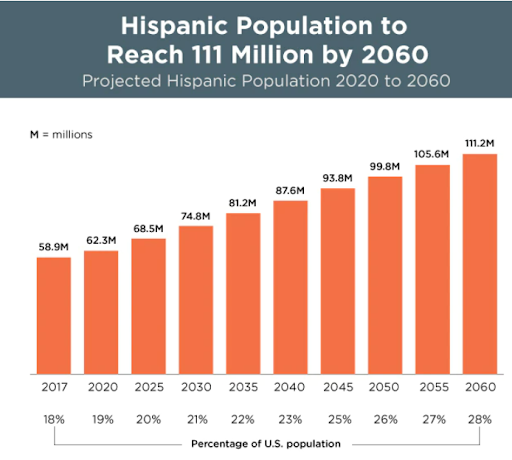Building For The Growing 50%
According to the most recent Census data, the white population in America decreased for the first time in history.
Building for and by the growing pool of non-white individuals presents an opportunity to serve historically underestimated and overlooked groups. In particular, we believe companies addressing the needs of specific minority groups will build large and lasting businesses by offering authentic products and tapping into the power of communities to scale – some examples include Sonoro, 54Gene, and Beautyocracy.
This is relevant to all minority and ethnic groups but taking advantage of Hispanic Heritage Month, we wanted to share how we’ve seen opportunities be created targeting this group across some of our focus categories, including money, food, and health.
For context: Hispanics represent ~60 million people living in the U.S. or ~20% of the population. According to the U.S. Census Bureau, this percentage is expected to grow to 28% of the U.S. population by 2060.

There is great diversity within the Hispanic population, but some trends are worth highlighting. Over 70% of them prefer to speak Spanish at home, according to Instituto Cervantes. Hispanics have a higher labor-force participation, faster population growth, and increasing consumer spending relative to the overall U.S. market. Anecdotally, Hispanics are also more likely to make decisions based on trust and cultural norms.
Talking about money is taboo in certain cultures, and it’s definitely not talked about enough in the Hispanic community. Some of this comes from the collective feeling that existing products and services are not built with the community in mind. But we are optimistic that diverse founders will seize the opportunity to build unique products and services.
For example, Sean and Kenny Salas built Camino Financial to provide affordable loans to LatinX small businesses. Most of the customer journey is in Spanish, and the company uses alternative data to underwrite loans more efficiently. Other companies working on exciting projects in the space include Suma, Ola, and Finhabits.
For major health decisions, the 70% of Hispanics who prefer to speak Spanish are left with limited options to navigate care. We are excited to see emerging companies like Lingo Health, MiSalud, and Spora Health that are purpose-built to serve specific immigrant communities taking into consideration language and cultural differences. By adjusting the language, the distribution, and/or the product to cater specifically to the Hispanic community, they are able to serve the true needs of the population and get to PMF.
And then there’s food. It’s at the heart of most community traditions and identities. The Hispanic community is lucky to have delicious and nutritious food traditions (shoutout to the Venezuelan Arepa for keeping home close wherever I am). Beyond the CPG and small restaurants that used to cater to the communities’ needs, we are seeing a handful of purpose-built tech players focus on serving the needs of these communities (Weeee!, Shef, and Bokksu).
We’re excited to see this next wave of startups that are created in an environment that celebrates diversity, and hope that the opportunity to build for these communities will lead to an increase in representation of minorities across funders and founders.
We are just getting started :)
Relevant Links:
-
Crunchbase: Funding to Hispanic or Latinx-founded companies in the U.S.
-
Crunchbase: LatinxVC Seeks To Boost Latinx VCs With The Help Of Silicon Valley Bank
Hi! I’m a new contributor to the blog. My name is Luisa Sucre, I was born and raised in Caracas, Venezuela. I’ve spent the last 10 years in the U.S. I studied Politics, Philosophy, and Economics at the University of Pennsylvania and worked as an investor at Revolution Growth before getting my MBA at Stanford. I joined Collaborative a few months ago and feel deeply connected to the firm’s mission to invest in founders and companies pushing the world forward. I spend most of my time working with companies in Money, Health, and Food (reach out if we could collaborate!) Most of my free time is spent running on the West Side Highway or trying to work my way through the steep learning curve of cooking 101.
Thanks for reading!